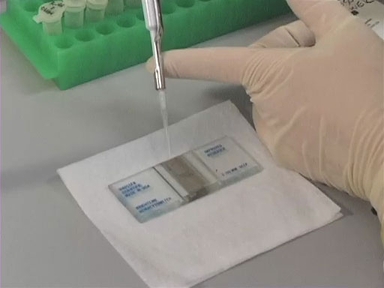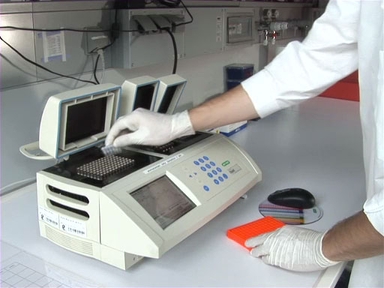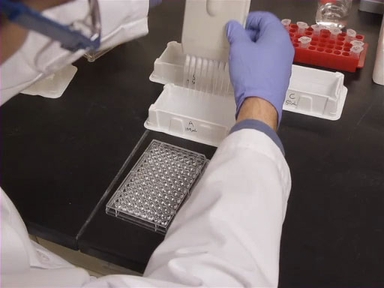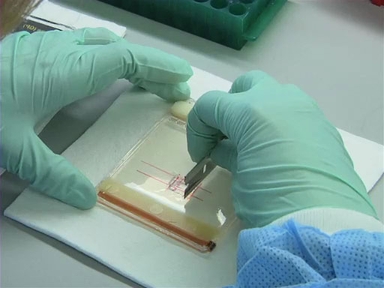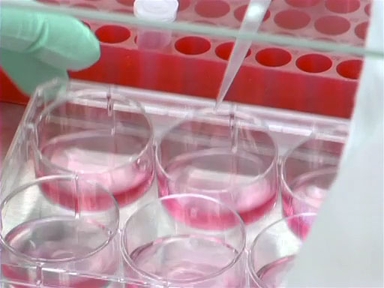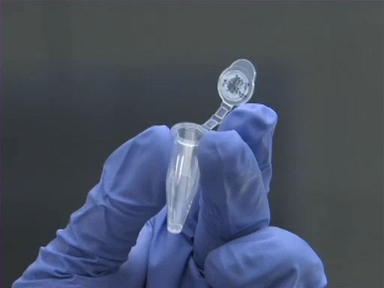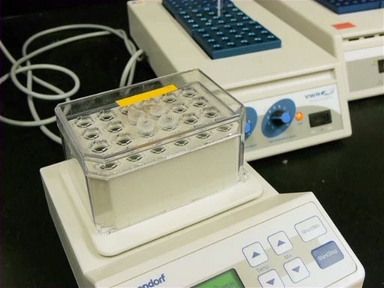Western Blotting is a powerful technique utilized by many researchers to identify the presence of specific proteins in an electrophoretically-separated sample using antibodies.
There are 3 principal stages of this technique that are essential for a quality outcome: Electroblotting, Immunoblotting, and Detection. Before these stages are attempted, SDS-PAGE, in which denatured proteins are separated by size in a polyacrylamide gel, must be performed.
Electroblotting, is also known as the Western “transfer” and requires a transfer cassette for holding together the “sandwich” as well as an apparatus for transferring protein from an acrylimide gel to a thin membrane. The electroblotting sandwich consists of the gel and a specialized membrane, sandwiched between two pieces of filter paper. During the transfer, an electric field is used, to move the proteins through the gel, where they become trapped on a membrane due to charged and hydrophobic interactions.
Immunoblotting uses antibodies to “probe” the membrane for specific proteins. Antibodies are large Y-shaped proteins that contain two fragments, also known as Fab regions, which bind to other proteins. The Fab region defines the specific epitope, or specific portion of a protein, to which an antibody will bind.
Monoclonal antibodies are antibodies that recognize a single epitope and are the preferred antibody type used for immunoblotting due to their specificity. In contrast, polyclonal antibodies are a series of different antibodies that target many epitopes on the same antigen – or protein for which an antibody has specificity. Monoclonal antibodies that recognize a linear epitope are preferred as that ensures the epitope can be found on a denatured, or linearized, protein. This is important because many antibodies only recognize conformational epitopes, which means that they recognize proteins in their native 3D state only.
In addition to Fab fragments, antibodies contain an Fc region, which is specific to the animal that produced the antibody. In immunoblotting, this region is mainly utilized as the epitope for a secondary antibody – an antibody which recognizes the first antibody that has bound to the protein you’re trying to detect.
In order to produce an observable signal, antibodies are often linked, through their Fc region, to a reporter enzyme, such as alkaline phosphatase or horseradish peroxidase. These reporter enzymes produce signals by reacting with substrates to cause color changes or produce light changes.
These changes can then be quantified using densitometry. Densitometry is the technique used to measure the density of a protein band using image analysis software to calculate the density of each band. The bands can then be directly quantified using reference standards or internally controlled using a control sample.
For a successful Western transfer, the gel is first equilibrated in transfer buffer for 15 minutes. The membrane should also be equilibrated according to manufactures instructions.
Next, the gel transfer sandwich is carefully prepared in transfer buffer to prevent bubbles from being trapped within the system. Bubbles trapped in the sandwich can be forced out by rolling over them with a small pipette. Even small bubbles can interrupt the transfer of proteins causing incomplete transfer as can be seen on the lower parts of this membrane.
Once assembled, additional transfer buffer is poured into the transfer chamber and it is run at 20-30 mA for 2-3 hours. Transfer buffer contains methanol, which enhances the binding of the proteins to the membrane.
Once the transfer is complete the cassette is disassembled and the quality of the transfer can be checked using a non-specific protein stain such as Ponceau S. This offers a quick and reversible detection of protein bands.
The first step of immunoblotting is to cover the remaining areas of the membrane with a dilute solution of proteins. This step is called blocking and is performed, in order to block the membrane and reduce the nonspecific binding of the antibody to the membrane. Typically, the blocking solution consists of either bovine serum albumin or non-fat dry milk dissolved in a buffered saline solution. This step is usually done for 1 hour to overnight on a shaker.
The next step is to incubate the membrane with the primary antibody diluted in the blocking solution. This step can take from 30 minutes to overnight and should be performed with gentle agitation.
Then, the membrane is thoroughly rinsed to reduce nonspecific background staining and the secondary antibody is added in blocking buffer to the membrane. After a short incubation, the membrane is again thoroughly rinsed.
Secondary antibodies are detectable thanks to the reporter enzymes that are tethered to them. Upon addition of the correct substrate, colorimetric or chemiluminescent changes can be imaged and then measured using densitometry techniques. In addition, the protein ladder provides a valuable size reference so that each protein’s linear size can be estimated based on how far it has migrated in the gel relative to the size markers in the ladder. Observing the size of proteins detected via immunoblotting is a good way to verify that the antibody is recognizing the correct protein and whether it is a monomer or a multiple copies of the protein that are being seen.
There are thousands of commercially available primary antibodies, which allows for the detection and quantification of specific proteins within a sample. Here a researcher uses an antibody for HIF-1α to measure the amount of this oxygen responsive transcription factor in cell cultures to screen for hypoxia. They also used an antibody for beta-actin to act as a loading control. As you can see, the cells cultured in normal oxygen conditions produced far less HIF-1 than those cultured in low oxygen conditions.
The combination of 2D gel electrophoresis and immunoblotting can provide valuable information into the presence of protein complexes. Here, samples were first run by protein complex size, and then denatured so each individual protein in the complex could be separated by their individual size. Antibodies for three different proteins show three unique complexes containing different numbers of these proteins with each complex arranged in a vertical line. The left most column contains beta-2 and MCP-21, as well as another protein not shown by these markers. The center column shows a complex that contained all 3 proteins, and the right column contained only beta-2 and MCP-21.
Immunoblotting can also be used to visualize protein-protein interactions. This is performed by first transferring proteins from a gel onto a nitrocellulose membrane and then probing that membrane with additional proteins. Immunoblotting is then used to detect the if the added proteins complexed with any of the proteins that were immobilized on the membrane.
You’ve just watched JoVE's video on immunoblotting. You should now understand how to transfer proteins to a membrane, probe the membrane with antibodies, and detect the signal. As always, thanks for watching!

